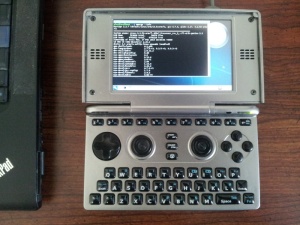Difference between revisions of "Gentoo"
From Pandora Wiki
m (→Extract Gentoo onto the SD card partitions) |
|||
| Line 28: | Line 28: | ||
| − | + | === '''Extract''' Gentoo onto the SD card partitions === | |
| + | |||
| + | # tar xapvf gentoo-pandora-2014.05.tar.bz2 -C /mnt/gentoo | ||
| + | # umount /mnt/gentoo/boot | ||
| + | # umount /mnt/gentoo | ||
| + | |||
| + | === ''' Wireless ''' === | ||
| − | |||
# Click the wifi icon in the tray. | # Click the wifi icon in the tray. | ||
# In the window, press scan. | # In the window, press scan. | ||
| Line 36: | Line 41: | ||
# Fill in the auth info and hit enter | # Fill in the auth info and hit enter | ||
# You should be connected now. It now will connect every time Gentoo starts. | # You should be connected now. It now will connect every time Gentoo starts. | ||
| − | |||
==== '''Installing packages''' ==== | ==== '''Installing packages''' ==== | ||
Revision as of 18:45, 24 June 2014
- Razor-qt 0.5.2 desktop
- Over 500 pre-built packages, including: Firefox 29.0, GIMP 2.8.10, QtCreator 2.8.1, gdb 7.6.2, Valgrind 3.9.0, gcc 4.7.3
- All the packages were built for Cortex-A8 (softfp), mostly Gentoo arm stable
Contents
Installation requirements
- Pandora All versions fine?
- SD card Minimum 2GB
Download the gentoo image
Partition the SD card
- mkfs.ext2 -L boot /dev/mmcblk0p1
- mkfs.ext4 -L gentoo -E stride=2,stripe-width=1024 /dev/mmcblk0p2
- mkdir -p /mnt/gentoo# mount /dev/mmcblk0p2 /mnt/gentoo
- mkdir /mnt/gentoo/boot
- mount /dev/mmcblk0p1 /mnt/gentoo/boot
Extract Gentoo onto the SD card partitions
- tar xapvf gentoo-pandora-2014.05.tar.bz2 -C /mnt/gentoo
- umount /mnt/gentoo/boot
- umount /mnt/gentoo
Wireless
- Click the wifi icon in the tray.
- In the window, press scan.
- "Double-click" your network (hit right nub up, might take a few tries if it's not tuned)
- Fill in the auth info and hit enter
- You should be connected now. It now will connect every time Gentoo starts.
Installing packages
- Open a terminal and run:
- $ su -
- Password:
- emerge -avK htop
- Updating the system using binary packages:
- emerge -auvDK @world
- Build portage tree to install prebuilt packages:
- emerge --sync (will take a while the first time)
- emerge -av wgetpaste
